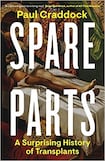
“Life is pleasant, death is peaceful, it’s the transition that’s troublesome,” wrote Isaac Asimov. He could have been talking about the troublesome tension illuminated in Spare Parts by medical historian Paul Craddock.
We are presented in the opening scenes with “scorched flesh” that “fills the operating theatre with the aroma of a Sunday barbecue”. The writer, observing a kidney transplant taking place, describes the donated organ as “discarded offal” and Mr Bhatti, who is receiving that kidney from his brother, has “kind eyes”, before the man disappears under the drapes to become, “the abdomen”. It is with this curious and clinical precision that we are invited into what Craddock calls “a cultural history of transplants”.
This is a book about trying to escape death, the medical innovations that keep us alive, and the contentious and cross-pollinating space occupied by human nature, machines and miracles. The cultural thread of transplant is measured in quacks, innovators and medical somersaults, told through the voice of a historian handling dense levels of research.
We go from the earliest record of skin grafting in the Sushruta Samhita to Lyon’s most famous embroiderer, Anne-Marie Lenroudier. Her intricate sewing skills informed the man considered the “father” of transplant surgery, eugenicist and misogynist Alexis Carrel, who failed to acknowledge Lenroudier’s contribution when he picked up a Nobel Prize.
The themes of erasure and experimentation thread through the book, and the discomfort of the arrangement probes an awareness in the reader. Willem Kolff, a member of the Dutch resistance in the second World War, used “an enamel bath ... a motor from a Ford and a few lengths of sausage skin” set in the frame of a “shot down German bomber” to create the first dialysis machine.
The innovation becomes murky as Gustave Boele, an elderly Jewish man with a prostate tumour – “forgotten by the occupying Germans” – becomes the first dialysis patient. Craddock writes that Boele would “certainly die” and that he does not appear in any medical records or in Kolff’s own papers.
While the past and the present reality of transplant are complex, the story of Boele was so disquieting that I checked the biography referenced for any hint of the man who died. In Spare Parts, the head nurse encourages Kolff to try the first dialysis machine on Boele. Descriptive writing gives intricate detail about how the machine malfunctioned and the “poor man ... died as expected”.
We arrive again at the mechanical language of the book’s opening scene that privileges the scientific over the tender, the medical detail over the man experiencing the moment.
I wonder if the stiffness of the material is merely a consequence of available information. However, the biography reveals something more heart-based. Kloff risked himself to treat Boele, his long-term patient, who the hospital called a “secret friend”. Throughout the book, this scene building is what the reader is missing. The narrative stays alert to the intricacies of churning blood and the meat-like consistency of organs, but it fails to slow down and reimagine the emotional context for donor and recipient.
The summary thoughts of the writer in the final chapter could have served as a structural engine had they arrived much earlier. The book raises questions about how we relate to one another, what stories we choose to privilege and who gets to tell them. It doesn’t unpack the emotional ways we deal with and survive the very thing Craddock has charted: transplant.
Without this, the prose remains medicalised, and the marvellous breadth of the book is suffocated by its tone. The opportunity of being alive and present and accountable to one another, the miracle and monstrosity created, means more space and a slower, thoughtful consideration is needed.
From the God of the Underworld tearing out his friends’ heart to imbue intelligence to stomach-churning experimentation on animals, the chosen research is meticulously collected. But I cannot rid myself of the Sunday barbecue smell. Did Mr Bhatti survive? Perhaps because I had a double lung transplant I am more sensitive.
Another young woman, Jennifer Sutton, staring at her dead heart inside a glass case display, is an image I’ve looked up because it sparked the passionate research that created this book. Curiously, Sutton – a heart transplant recipient – is included in the acknowledgments for teaching that “transplant surgery goes beyond its image as a sterilised, scrubbed-up hospital affair”.
The writer and the woman never met, but this touchstone – the point of origin for this work – feels important. It is the tenderness with which Craddock connects to this image that would have benefited the text itself.










